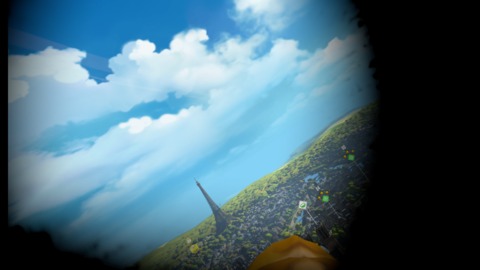Somewhat small in scope, but a step forward in VR
Last March, Jason Rubin of Oculus Studios brought up Ubisoft and Eagle Flight in an interview to Road to VR (https://youtu.be/N-ds-EiR5ls?t=10m46s). He praised them them about their research into locomotion and taking risks to create a VR game with a lot of movement. He said, "This may be the foundation of locomotion working in VR... I might have, had they come to me, said 'Not sure I want to bet my dollar on that', but that was a dollar well bet".
The onus has been placed in Eagle Flight and Ubisoft to deliver on new ways to present fast movement and traversal in VR with without the dreaded motion sickness that is a hurdle to every VR developer. Now the game is out, and I can verify that they have indeed created a new 'foundation' for traversing and navigating over long distances in VR, yet there could be room for some tweaks down the road.
Eagle Flight is fundamentally basic as far as game play is concerned. Ubisoft pressed another one through their development cookie cutter to produce yet another city map with arbitrary mission points and collectibles. The real star of this show is the mechanics within that cookie. Just as how the first Assassin's Creed opened up a new era of easy open world traversal, Eagle Flight may be the first game to prove easy open world traversal in VR.
In Eagle Flight, you assume the body of an Eagle in a post-human Paris, France. There is a very light story that is nothing more than servicing new game mechanics and tougher challenges, and is nothing to really concern yourself with. As an eagle you soar, dip, and dive around the ruins of Paris. Missions vary between darting through race courses and screaming balls of air at foes. These activities take you swooping and darting through city ruins and underground passages. This is nothing new if you ever played any 'fly through the rings' game since the invention of 3D gaming. This is also something to generally worry about in VR, which is prone to get you out of whack if there is too much movement on the screen. Most games that involve flying present you with some type of grounding, such as a cockpit. As an eagle you inherently do not have a cockpit, so Ubisoft Montreal designed a whole new dynamic system that actually works better than any cockpit can, and makes the swooping and diving an exhilarating experience.

When you turn and swoop in Eagle Flight, sides of the screen "black out" to prevent you the player from receiving too much movement stimuli at the edges of your vision (see image right). This effect still needs some tuning however, or even the ability of further customization from the player, but it is a good start. There are times the effect feels too much like tunnel-vision (ever start blacking out on a roller coaster?). The effect also appears when you are too close to a nearby wall, which is distracting as it pulsates in and out of your vision for just passing near something. It also feels out of place when you are slowly gliding high above the city. But when you are in the thick of swooping around walls, trees, or towers, I could say I hardly even noticed it, as I was too focused on what was directly ahead of me. The effect did surprisingly well to thwart any motion induced vertigo without even being apparent it was working at the sides of my vision. There is a lot of potential to applying this effect to anything VR with fast turning motion, hopefully getting rid of some of the immersion breaking "comfort" modes in many games. Tweaks needed would make the effect more dynamic to the mix of environment and movement. I may not need much of an effect flying over the city high up, but I sure need it when flying really fast through a tunnel. It appears Ubisoft Montreal has taken some care to optimize how the effect reacts, but the effect is generally too heavy for me personally, or appears when I don't need it.
Control of your Eagle in Eagle Flight uses the tilt of the HMD exclusively. Fortunately, the sensitivity for this is adjustable. The default setting requires you to tilt your head at an uncomfortable bend if you are just sitting. Lower sensitivities make sense if you play the game standing, and can lean your whole body to compensate. I do wish there were an option to turn on thumbsticks. For me, this has been another issue of what is best for the right situation. If I am flying high above the city to look for the next objective, twisting my head around to search is an awkward chore. If I am swooping through tunnels and around towers, the head tilt is instead so natural that I will instinctively jerk and turn my head away if I am about to run into a random column that popped out in front of me. The moments when your instinctive flinches work in the game naturally to get out of tight spots feel really awesome, and are the fix of what keeps me coming back to get the best time in challenges.
This is a very good start for a new foundation in VR locomotion. I do not think this game in particular will hold up to future games, no more than Pilot Wings for the SNES (although revered) could hold a candle to Starfox, but it is worth it as a fully realized potential of where VR can go from here.
